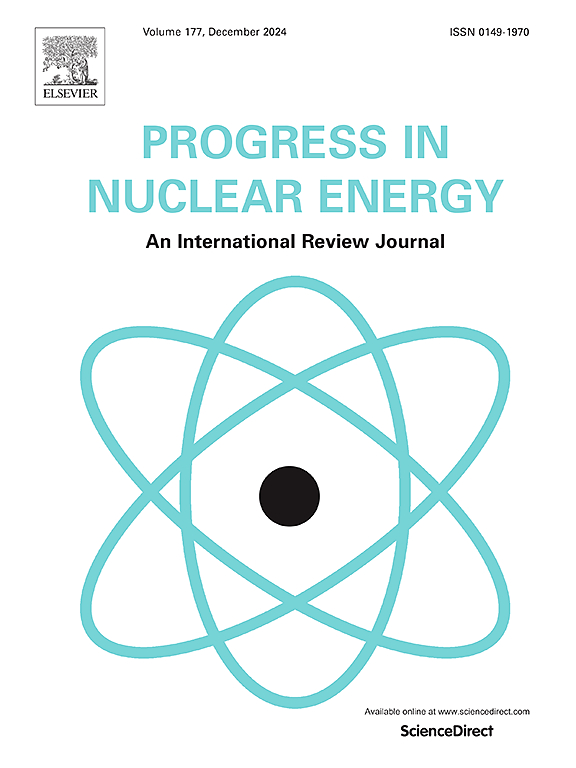Investigation on effect of mixing factor on developing CHF correlation for fuel assembly
IF 3.3
3区 工程技术
Q1 NUCLEAR SCIENCE & TECHNOLOGY
引用次数: 0
Abstract
The Safety Margin in CHF correlation development is one important criterion of reactor safety analysis. Current critical heat flux correlation development relies on the accuracy of input thermal-hydraulic parameters, leading to the difficulty of reducing uncertainty. The turbulent mixing, which is simply modeled as a diffusion process, has a great influence on the distribution of local parameters and the safety margin of a certain correlation. To find the influence of the subchannel analysis program on CHF correlation development, In this paper, a critical heat flux (CHF) correlation is developed using the minimum departure of nucleate boiling ratio (MDNBR) method based on the subchannel code. The DNBR limit is determined using the Owen criterion and statistically evaluated. Then analysis is conducted on the estimation performance, DNBR limits and actual maximum heat flux of the corresponding correlation for different mixing factors. Results shows that the mixing factor contributes to the redistribution of local parameters. Besides, the relationship is weak between the accuracy of the correlation prediction and the value of the mixing factor bias. However, CHF correlations developed based on precise mixing factors obtained from experiments have the best accuracy and safety margin. The work is meaningful for the refinement of mixing effects for grid spacers in subchannel codes.
混合系数对燃料组件CHF相关性影响的研究
CHF相关发展中的安全裕度是反应堆安全分析的一个重要标准。目前的临界热流密度关联发展依赖于输入热工参数的准确性,导致降低不确定性的困难。将湍流混合简单地建模为扩散过程,对局部参数的分布和一定相关性的安全裕度有很大的影响。为了研究子通道分析程序对CHF相关性发展的影响,本文采用基于子通道代码的最小离核沸腾比(MDNBR)方法,建立了临界热流密度(CHF)相关性。DNBR限值采用欧文准则确定并进行统计评估。然后分析了不同混合因子下对应相关性的估计性能、DNBR极限和实际最大热流密度。结果表明,混合因子有助于局部参数的再分布。此外,相关预测精度与混合因子偏差值之间的关系较弱。而基于实验得到的精确混合因子建立的CHF相关性具有最好的精度和安全裕度。该工作对子信道码中网格间隔器混合效果的细化具有重要意义。
本文章由计算机程序翻译,如有差异,请以英文原文为准。
求助全文
约1分钟内获得全文
求助全文
来源期刊

Progress in Nuclear Energy
工程技术-核科学技术
CiteScore
5.30
自引率
14.80%
发文量
331
审稿时长
3.5 months
期刊介绍:
Progress in Nuclear Energy is an international review journal covering all aspects of nuclear science and engineering. In keeping with the maturity of nuclear power, articles on safety, siting and environmental problems are encouraged, as are those associated with economics and fuel management. However, basic physics and engineering will remain an important aspect of the editorial policy. Articles published are either of a review nature or present new material in more depth. They are aimed at researchers and technically-oriented managers working in the nuclear energy field.
Please note the following:
1) PNE seeks high quality research papers which are medium to long in length. Short research papers should be submitted to the journal Annals in Nuclear Energy.
2) PNE reserves the right to reject papers which are based solely on routine application of computer codes used to produce reactor designs or explain existing reactor phenomena. Such papers, although worthy, are best left as laboratory reports whereas Progress in Nuclear Energy seeks papers of originality, which are archival in nature, in the fields of mathematical and experimental nuclear technology, including fission, fusion (blanket physics, radiation damage), safety, materials aspects, economics, etc.
3) Review papers, which may occasionally be invited, are particularly sought by the journal in these fields.
 求助内容:
求助内容: 应助结果提醒方式:
应助结果提醒方式:


